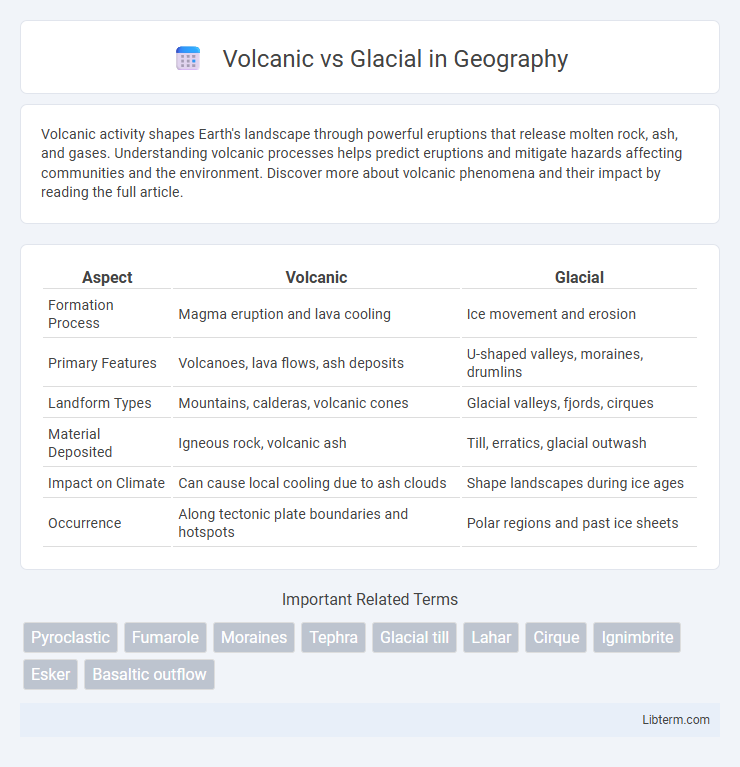Volcanic activity shapes Earth's landscape through powerful eruptions that release molten rock, ash, and gases. Understanding volcanic processes helps predict eruptions and mitigate hazards affecting communities and the environment. Discover more about volcanic phenomena and their impact by reading the full article.
Table of Comparison
| Aspect | Volcanic | Glacial |
|---|---|---|
| Formation Process | Magma eruption and lava cooling | Ice movement and erosion |
| Primary Features | Volcanoes, lava flows, ash deposits | U-shaped valleys, moraines, drumlins |
| Landform Types | Mountains, calderas, volcanic cones | Glacial valleys, fjords, cirques |
| Material Deposited | Igneous rock, volcanic ash | Till, erratics, glacial outwash |
| Impact on Climate | Can cause local cooling due to ash clouds | Shape landscapes during ice ages |
| Occurrence | Along tectonic plate boundaries and hotspots | Polar regions and past ice sheets |
Understanding Volcanic and Glacial Landscapes
Volcanic landscapes are characterized by features such as lava flows, volcanic cones, craters, and ash deposits formed through eruptions of molten rock and gases from Earth's mantle. Glacial landscapes display distinct geomorphological elements like U-shaped valleys, moraines, drumlins, and fjords shaped by the movement and melting of glaciers over time. Understanding these landscapes involves analyzing the processes of volcanic activity and glacial dynamics that sculpt Earth's surface, influencing soil composition, topography, and ecosystem development.
Origins: How Volcanic and Glacial Features Form
Volcanic features form through the eruption of magma from beneath the Earth's crust, creating landforms such as volcanoes, lava plateaus, and volcanic islands. Glacial features result from the movement and melting of glaciers, which erode and deposit sediments to form valleys, moraines, and fjords. Both processes shape the landscape, but volcanic formation is driven by internal Earth heat, while glacial formation is influenced by climatic conditions and ice dynamics.
Key Differences in Geology
Volcanic landforms are primarily shaped by the eruption and solidification of molten lava, resulting in features such as cones, calderas, and lava plateaus composed mainly of igneous rock. Glacial geology is characterized by the erosion, transport, and deposition of sediments through the movement of ice, producing landforms like moraines, drumlins, and U-shaped valleys dominated by unconsolidated materials. The key difference lies in volcanic processes originating from internal Earth heat and magma activity, while glacial processes are driven by climate-induced ice dynamics reshaping the surface through mechanical weathering and sediment redistribution.
Surface Features: Volcanic vs Glacial Landforms
Volcanic landforms such as lava domes, cinder cones, and shield volcanoes result from the accumulation and solidification of magma on the Earth's surface, creating rugged, often conical shapes with cratered summits. Glacial landforms, including moraines, drumlins, and U-shaped valleys, form through the movement and melting of glaciers, sculpting smooth, rounded terrain and depositing unsorted debris called till. The stark contrast between the jagged volcanic features and the smoothed, carved glacial landscapes highlights the differing geological processes of magma extrusion versus ice erosion.
Impact on Soil Composition and Fertility
Volcanic soils, rich in minerals like basalt and ash, often contain high levels of potassium, phosphorus, and trace elements that enhance soil fertility and support robust plant growth. Glacial soils, derived from finely ground rock flour, tend to have varied nutrient content but are typically less fertile due to lower organic matter and essential mineral concentrations. The rapid breakdown of volcanic materials releases nutrients quickly, whereas glacial deposits require longer weathering periods to develop comparable fertility levels.
Volcanic Eruptions Compared to Glacial Movements
Volcanic eruptions release magma, ash, and gases from deep within the Earth, causing rapid and often violent landscape changes, whereas glacial movements involve the slow, steady flow of ice reshaping terrains over thousands of years. Eruptions can create new landforms such as lava plateaus and volcanic cones, while glaciers carve valleys and fjords through persistent erosion. The intensity and speed of volcanic activity contrast sharply with the gradual, consistent nature of glacial movement, impacting ecosystems and human settlements differently.
Biodiversity in Volcanic and Glacial Regions
Volcanic regions often harbor unique biodiversity due to nutrient-rich soils supporting diverse plant species and specialized fauna adapted to extreme conditions. In contrast, glacial areas exhibit lower biodiversity because cold temperatures and ice coverage limit species variety, though some extremophiles and cold-adapted organisms thrive there. The dynamic landscapes of volcanic zones promote ecological succession and habitat diversity, while glacial retreat can create new habitats, influencing species distribution over time.
Climate Influence on Volcanic and Glacial Activity
Volcanic activity significantly influences local and global climates by releasing vast amounts of ash and greenhouse gases like CO2 and sulfur dioxide, which can cause short-term cooling or long-term warming effects. Glacial activity is strongly driven by climatic conditions, as temperature fluctuations determine glacier advance or retreat, influencing sea levels and regional weather patterns. The interaction between volcanic eruptions and glacial ice, such as subglacial eruptions, also affects glacier melting rates and volcanic hazards.
Hazards and Environmental Risks
Volcanic eruptions release ash, lava, and toxic gases, causing widespread damage to ecosystems, air quality, and human health, while triggering mudflows and earthquakes. Glacial hazards include glacial lake outburst floods (GLOFs), rapid ice melt, and landslides, which threaten downstream communities and freshwater resources. Both volcanic and glacial hazards contribute to long-term environmental risks such as habitat destruction and altered hydrological cycles.
Human Interaction with Volcanic and Glacial Environments
Human interaction with volcanic environments includes harnessing geothermal energy, farming fertile volcanic soils, and facing risks like eruptions and lava flows. In glacial regions, humans depend on glaciers for freshwater resources, tourism, and scientific research while confronting challenges from glacial melting and habitat changes. Both environments require adaptive strategies to balance benefits and hazards in response to natural dynamics.
Volcanic Infographic

 libterm.com
libterm.com